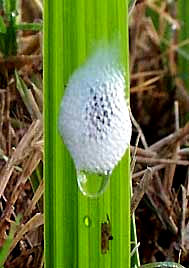Excerpts from Jim Conrad's
Naturalist Newsletter
from the September 21, 2007 Newsletter issued from Sierra Gorda Biosphere Reserve, QUERÉTARO, MÉXICO
SPITTLEBUGS
 During recent days we've had several nights of rain, then the next morning sunbeams would slant in from over the eastern mountains lighting up grassblades tipped with water droplet and acacia leaflets shiny and bejeweled. On many grassblades also there have been spittlebugs enshrouded with white foam, as you can see at the right.
During recent days we've had several nights of rain, then the next morning sunbeams would slant in from over the eastern mountains lighting up grassblades tipped with water droplet and acacia leaflets shiny and bejeweled. On many grassblades also there have been spittlebugs enshrouded with white foam, as you can see at the right.
Folks here call the white, spittle-like blobs angelitos, which means "little angels," and that makes sense when you see the glowing, white globules held aloft on their grassblades.
Despite gracing spittlebug spit-blobs with such a benign name, Don Gonzalo also calls them a plaga, a sort of plague on the plants they appear on. For, inside each cluster of bubbles there's an immature insect, a nymph, with a slender, strawlike proboscis inserted into the plant's conducting tissue, robbing the plant of its juices. In the above picture you can barely make out something dark in the blob's center, and that's the nymph.
Insect nymphs constitute the middle stage of incomplete insect metamorphosis. Remember that the stages of complete metamorphosis undergone by such insects as butterflies and moths are:
EGG --> LARVA --> PUPA --> ADULT
The stages of incomplete metamorphosis are:
EGG --> NYMPH --> ADULT
Insect nymphs are similar to adults, except that they're smaller, have no wings or their wings aren't yet fully developed, and the nymph usually has a paler color than the adult.
That's the way it is with spittlebug nymphs. They look a lot like their adult stages, except that they're smaller, wingless, and paler. Several photos of spittlebugs in their nymphal and adult forms are shown at http://bugguide.net/node/view/145/bgimage.
The adults are often called froghoppers because their blunt heads have goggly eyes, and they are very powerful hoppers. They're closely related to cicadas and aphids. Other insect groups with incomplete metamorphosis, and therefore with nymphal stages, include dragonflies, grasshoppers, "true bugs" such as stinkbugs, and termites and earwigs.